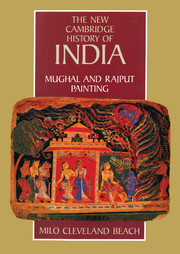Book contents
- Frontmatter
- Introduction
- 1 Painting in North India before 1540
- 2 1540–1580: Painting at Muslim courts
- 3 1580–1600: The new imperial style and its impact
- 4 1600–1660: Mughal painting and the rise of local workshops
- 5 1660–1700: The growth of local styles
- 6 1700–1800: The Dominance of Rajput Painting
- 7 1800–1858: Traditionalism and new influences
- Appendix
- Bibliographical essay
- Index
- The New Cambridge History of India
- References
4 - 1600–1660: Mughal painting and the rise of local workshops
Published online by Cambridge University Press: 28 March 2008
- Frontmatter
- Introduction
- 1 Painting in North India before 1540
- 2 1540–1580: Painting at Muslim courts
- 3 1580–1600: The new imperial style and its impact
- 4 1600–1660: Mughal painting and the rise of local workshops
- 5 1660–1700: The growth of local styles
- 6 1700–1800: The Dominance of Rajput Painting
- 7 1800–1858: Traditionalism and new influences
- Appendix
- Bibliographical essay
- Index
- The New Cambridge History of India
- References
Summary
IMPERIAL PAINTING AND THE RISE OF LOCAL WORKSHOPS
The Akbarnamas were official state documents meant to dazzle with their splendour, and to create, uphold, and reinforce tradition. Other works, made for private imperial appreciation, therefore introduce more clearly and easily the new concerns that will dominate Mughal painting during the first three decades of the seventeenth century, and which are only hinted at in the later Akbarnama. These tend to be books of poetry, such as the Nafahat al-uns, dated 1604–1605 (fig. 46). As with the circa 1588 Diwan of Anwari (fig. 34), with which it is closely linked in format and taste, the paintings of this book are smaller in size than those of the historical manuscripts or the majority of known Lahore period volumes. They contain far fewer figures and descriptive details, and here too illustrations are by individual artists rather than being the result of shared workmanship. And more than ever before, they have become revelations of personal artistic sensibility. It is no longer the narrative or the sheer quantity of visual material that attracts us, but the profound interest in individuals and their interaction. A badly creased page inscribed to Balchand, The Donkey’s Refusal (fig. 46), exemplifies this. The story is about a Shaikh who tried to take his donkey to fetch wine, but the animal refused to move until his master had renounced such pleasures. This potentially lively story is not what interests Balchand, however; the donkey is outside the main area of interest and obviously incidental. Instead the artist concentrates on a drinking party, and among the five seated men - the others are servants - the emotions are almost palpable.
- Type
- Chapter
- Information
- Mughal and Rajput Painting , pp. 68 - 156Publisher: Cambridge University PressPrint publication year: 1992

